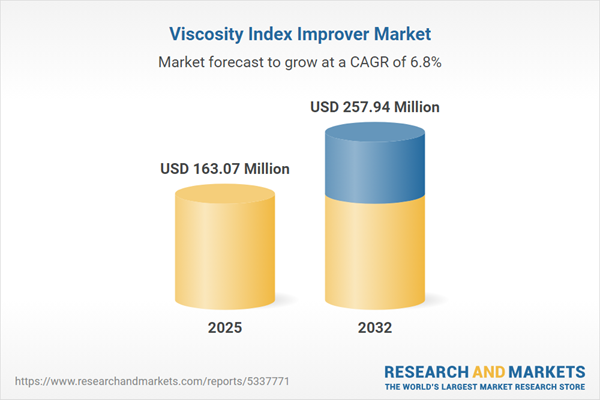Speak directly to the analyst to clarify any post sales queries you may have.
The viscosity index improver market is evolving rapidly due to increased demands for superior lubricant performance and growing regulatory mandates. Senior decision-makers are seeking data-driven insights to inform global sourcing, product development, and risk mitigation strategies in this competitive landscape.
Market Snapshot: Growth, Trends, and Outlook for Viscosity Index Improvers
The global viscosity index improver market registered growth from USD 152.81 million in 2024 to USD 163.07 million in 2025, with a projected compound annual growth rate (CAGR) of 6.76% through 2032. Market expansion is influenced by technological innovation in polymer additives, strategic moves by leading manufacturers, and shifts driven by regulatory and supply chain factors. This report analyzes recent trends, highlighting the interplay of performance requirements, sustainability imperatives, and trade policy changes affecting market dynamics.
Scope & Segmentation of the Viscosity Index Improver Market
This research thoroughly explores the viscosity index improver market across several crucial dimensions:
- Applications:
- Engine Oil—distinct strategies for commercial and passenger vehicles
- Gear Oil
- Hydraulic Fluid
- Industrial Grease
- Polymer Types:
- Olefin Copolymer
- Polymethacrylate
- Styrene Diene Copolymer (Hydrogenated, Non-Hydrogenated)
- End Use Industries:
- Automotive—including commercial and passenger vehicle subsegments
- Industrial—spanning manufacturing and power generation requirements
- Geographic Coverage:
- Americas (United States, Canada, Mexico, Brazil, Argentina, Chile, Colombia, Peru)
- Europe, Middle East & Africa (UK, Germany, France, Russia, Italy, Spain, Netherlands, Sweden, Poland, Switzerland, UAE, Saudi Arabia, Qatar, Turkey, Israel, South Africa, Nigeria, Egypt, Kenya)
- Asia-Pacific (China, India, Japan, Australia, South Korea, Indonesia, Thailand, Malaysia, Singapore, Taiwan)
- Leading Companies:
- The Lubrizol Corporation
- Afton Chemical Corporation
- Chevron Oronite Company LLC
- Infineum International Limited
- BASF SE
- Evonik Industries AG
- Croda International Plc
- Kraton Corporation
- Innospec Inc.
- China Petroleum & Chemical Corporation
Key Takeaways for Decision-Makers
- Viscosity index improvers are transforming lubricant performance across automotive, industrial, and marine sectors, helping companies manage equipment reliability and lifecycle costs.
- Shifts towards electric vehicles and regulatory requirements for emission reduction are driving formulation innovation and the adoption of bio-based and advanced copolymer additives.
- Digitalization, including real-time viscosity monitoring and advanced analytics, is enabling predictive maintenance and rapid response to performance deviations, offering operational advantages for manufacturers and end-users.
- Regional growth drivers vary, with the Americas focusing on heavy-duty engine protection, Europe, Middle East & Africa advancing toward renewable and low-friction lubricant solutions, and Asia-Pacific benefiting from robust industrial and automotive expansion.
- Strategic moves—such as R&D investment, local production expansions, and value chain integration—are helping key players respond to evolving market and customer needs while addressing sustainability and supply chain risks.
Tariff Impact on the Viscosity Index Improver Supply Chain
Recent changes in U.S. tariff policy have introduced complexities for viscosity index improver supply chains. Import duties on raw polymer inputs and finished additives have led companies to adjust production footprints, diversify sourcing, and pursue domestic manufacturing partnerships. Enhanced supply chain agility and local vendor development are emerging as core strategies for mitigating price volatility and safeguarding against international trade disruptions.
Research Methodology & Data Sources
This study utilizes a blend of primary interviews, secondary literature review, and quantitative modeling. Engagements with executives, scientists, and supply chain managers across regions supplied qualitative and technical perspectives, while data triangulation ensured reliability. Scenario modeling and iterative peer review anchored the findings for validity and strategic relevance.
Why This Report Matters
- Enables procurement and R&D leaders to benchmark strategies amid changing regulatory, technological, and supply chain conditions.
- Provides executives with region-specific trends and actionable intelligence for product portfolio alignment and growth planning.
- Highlights innovation pathways and sustainability considerations critical to maintaining long-term market competitiveness.
Conclusion
The viscosity index improver market is advancing, shaped by technological progress, sustainability imperatives, and resilient supply practices. Organizations prepared to anticipate industry shifts and leverage innovative solutions will be best positioned for sustained success.
Additional Product Information:
- Purchase of this report includes 1 year online access with quarterly updates.
- This report can be updated on request. Please contact our Customer Experience team using the Ask a Question widget on our website.
Table of Contents
3. Executive Summary
4. Market Overview
7. Cumulative Impact of Artificial Intelligence 2025
Companies Mentioned
The companies profiled in this Viscosity Index Improver market report include:- The Lubrizol Corporation
- Afton Chemical Corporation
- Chevron Oronite Company LLC
- Infineum International Limited
- BASF SE
- Evonik Industries AG
- Croda International Plc
- Kraton Corporation
- Innospec Inc.
- China Petroleum & Chemical Corporation
Table Information
| Report Attribute | Details |
|---|---|
| No. of Pages | 185 |
| Published | October 2025 |
| Forecast Period | 2025 - 2032 |
| Estimated Market Value ( USD | $ 163.07 Million |
| Forecasted Market Value ( USD | $ 257.94 Million |
| Compound Annual Growth Rate | 6.7% |
| Regions Covered | Global |
| No. of Companies Mentioned | 11 |









